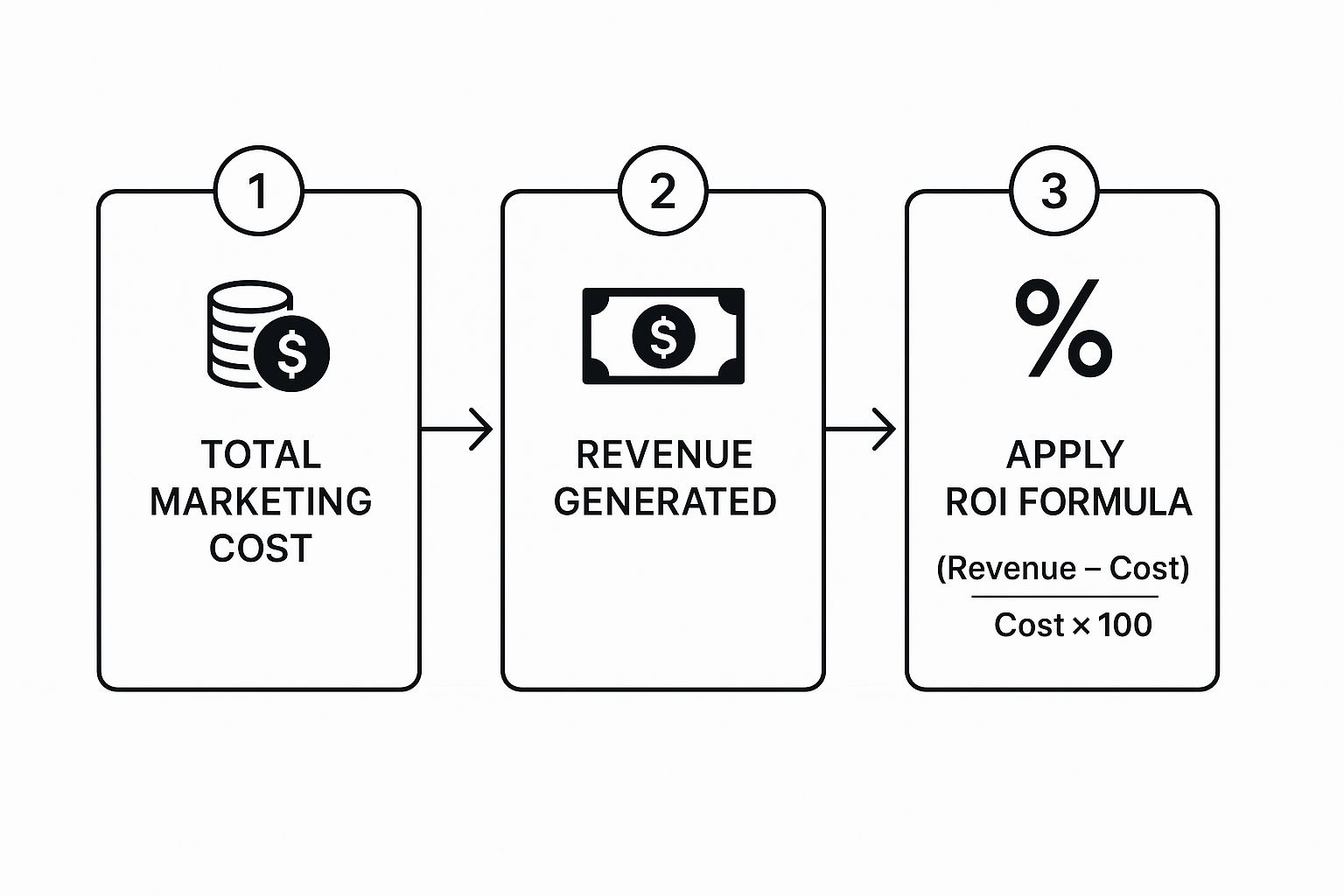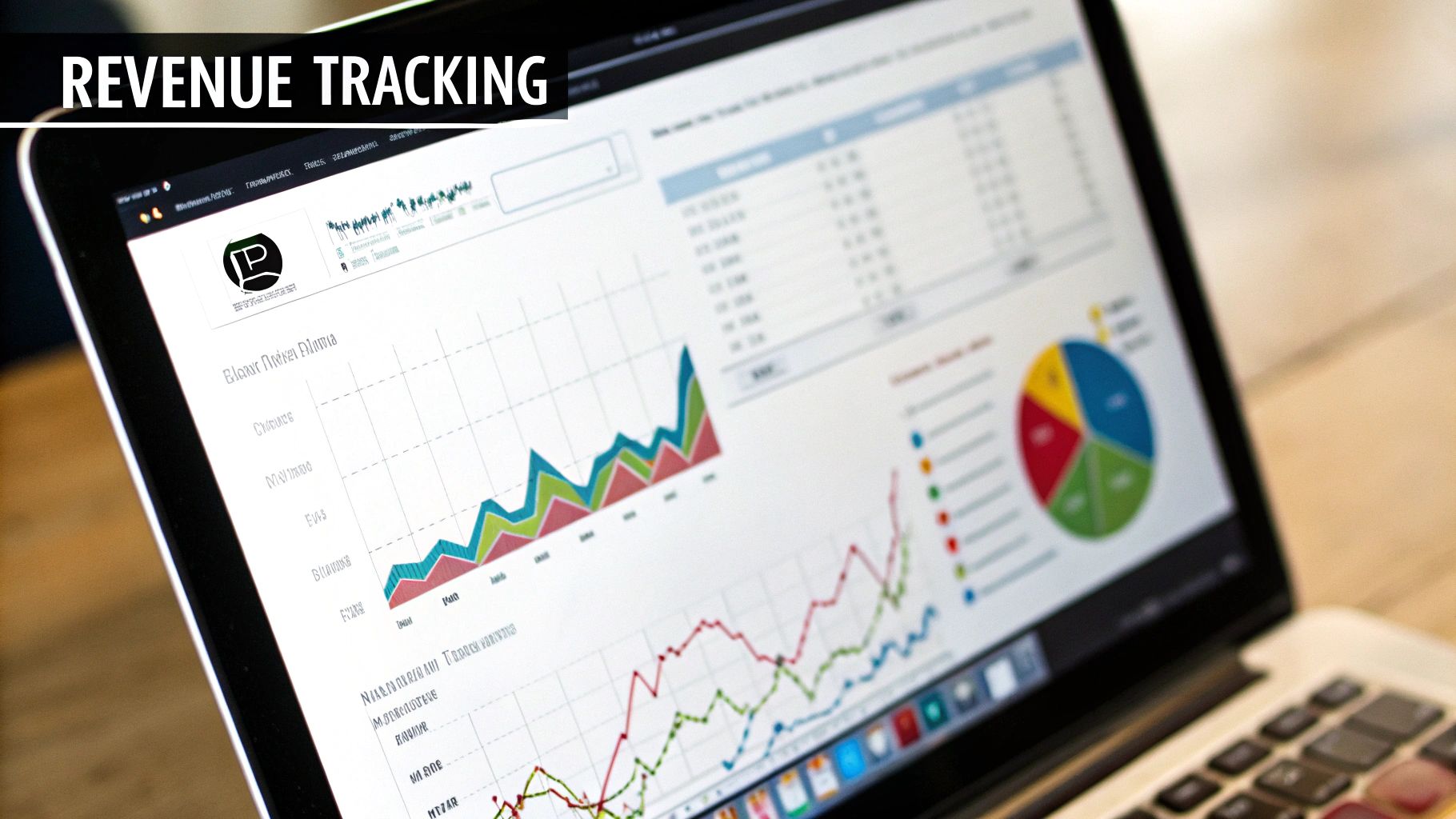How to Calculate Marketing ROI for UK Businesses

To work out your marketing ROI, you take the sales growth from your campaign, subtract your marketing costs, and then divide that number by the marketing costs. The classic formula looks like this: (Sales Growth – Marketing Costs) / Marketing Costs.
This simple bit of maths is what turns your marketing spend from a hopeful punt into a measurable driver of revenue.
Why Marketing ROI Is Your Most Important Metric
Let’s get past the textbook definition. For any business in the UK, getting your head around marketing ROI isn’t just about putting together a few reports—it’s about survival and smart growth. In today’s market, mastering this one metric is non-negotiable.
Think about it this way: running marketing without calculating ROI is like driving your car with the dashboard blacked out. You know you’re using fuel (your budget), but you’ve got no clue how fast you’re going, how much you’ve got left in the tank, or if you’re even heading in the right direction. Tracking ROI is like switching all the gauges on. Suddenly, you’ve got the data to make intelligent decisions.
Turning Costs into Revenue Engines
The biggest change you’ll see when you consistently track ROI is in perception. Marketing stops being seen as just another cost centre and becomes a proven engine for generating revenue.
When you can walk into a budget meeting and show that every £1 invested in a specific campaign brought back £5, you’re not just asking for more money. You’re presenting a profitable investment opportunity. This is the language that everyone, from the finance team to the CEO, understands and respects. It’s how you justify bigger budgets and get the resources you need to scale up.
I’ve run campaigns where the return looked minimal at first, but over time, it paid off massively through customer retention and referrals. The real question isn’t, ‘What’s a good ROI?’ but, ‘Is this ROI driving meaningful growth for the business?’
Empowering Strategic Decisions
Consistently tracking ROI gives you the confidence to optimise your efforts. You can clearly see which channels are smashing it and which are just eating up your budget.
For instance, if you discover your email marketing is delivering a 300% ROI while your social media ads are only managing 50%, you know exactly where to shift your money for maximum impact. This data-driven approach takes the guesswork out of the equation, allowing for proactive, strategic tweaks that directly fuel business growth.
This level of insight is absolutely crucial for navigating the choppy waters of modern marketing. For those of us deep in paid advertising, understanding these returns is even more critical. Our guide on mastering ROI for paid advertising shares essential strategies to help you get the most from your investment, ensuring every pound spent contributes directly to your bottom line.
Laying the Groundwork for Accurate Marketing ROI Tracking
Before you even think about plugging numbers into a formula, you need to build a solid foundation. Let’s be honest: trying to calculate marketing ROI without the right prep work is just glorified guesswork. Getting this groundwork right ensures your final figures are not just accurate, but actually tell you how your marketing is impacting the business.
First things first, we need to move past vague goals like ‘increasing brand awareness’. Your campaign objectives have to be specific, measurable, and tied directly to a real business outcome. Are you aiming to generate a specific number of qualified leads for the sales team? Or maybe hit a certain sales volume for a new product launch?
Think of these clear goals as your north star. They guide every decision you make and make it possible to define what real success looks like. Without them, you’re just measuring activity, not achievement.
Pinpointing Your Key Performance Indicators
With clear objectives in place, you can now identify the right Key Performance Indicators (KPIs) to track your progress. These metrics are the vital signs of your marketing’s health, and they vary massively from one channel to the next.
For an e-commerce business, for example, your crucial KPIs might be things like:
- Average Order Value (AOV): The average amount spent each time a customer buys something.
- Customer Acquisition Cost (CAC): The total cost to bring in one new paying customer.
- Conversion Rate: The percentage of your website visitors who end up making a purchase.
On the other hand, a B2B company focused on lead generation will care more about metrics like Cost Per Lead (CPL) and the rate at which Marketing Qualified Leads (MQLs) turn into Sales Qualified Leads (SQLs).
Choosing the wrong KPIs is like using a thermometer to measure how tall you are – the data you get will be completely useless for calculating a meaningful ROI. Many businesses I’ve worked with find that focusing on a few critical metrics gives them far more clarity than trying to track dozens of less important ones.
The biggest mistake I see is when teams default to tracking vanity metrics. High engagement on social media is nice, but if it doesn’t translate into leads or sales, it doesn’t contribute to a positive ROI. Focus on the metrics that directly connect marketing activity to revenue.
To get a clearer picture, it helps to map out the core metrics for each of your channels.
Key Metrics to Track Across Marketing Channels (How to Calculate Marketing ROI )
This table breaks down some of the most common marketing channels and the essential revenue and cost metrics you should be tracking for each. Getting these figures right is the bedrock of any solid ROI calculation.
| Marketing Channel | Essential Revenue Metrics | Essential Cost Metrics |
|---|---|---|
| PPC (e.g., Google Ads) | Revenue from Ad Clicks, Conversion Value | Ad Spend, Management Fees, Tool Subscriptions |
| Content Marketing | Leads from Content, Sales from Leads | Content Creation Costs, Freelancer/Agency Fees |
| Email Marketing | Revenue per Email, Sales from Campaigns | Platform Subscription, Design/Copywriting Costs |
| Social Media (Paid) | Sales from Social Ads, Lead Gen Value | Ad Spend, Creative Production, Agency Fees |
| SEO | Revenue from Organic Traffic, Value of Organic Leads | SEO Agency/Consultant Fees, Tool Costs |
Remember, this isn’t exhaustive, but it’s a great starting point for seeing how revenue and costs stack up across your different activities.
Establishing Reliable Tracking and Attribution
Now that your goals and KPIs are defined, the next critical job is setting up a reliable tracking system. This means integrating tools like Google Analytics, your Customer Relationship Management (CRM) platform, and any marketing automation software you’re using. The goal here is a seamless flow of data that follows a customer from their very first interaction all the way to the final sale.
This is also where you need to get serious about your attribution model—the rule you use to give credit for a sale to different touchpoints in the customer journey. The simplest, and most common, models are:
- First-Touch Attribution: Gives 100% of the credit to the very first channel a customer interacted with.
- Last-Touch Attribution: Gives 100% of the credit to the final touchpoint before the sale.
While they are simple, these models can be pretty misleading. A customer might discover your brand through a blog post (first touch) but only convert weeks later through a targeted Google Ad (last touch). It’s vital to acknowledge the full journey.
For paid campaigns, in particular, understanding how to get the most from your spend is paramount. You can dive deeper into this with our expert strategies for maximising your ROI with Google Pay Per Click advertising. Making sure your data is clean and your attribution model is chosen thoughtfully is completely non-negotiable for an accurate ROI calculation.
The Core Formulas for Calculating Marketing ROI
Right, you’ve got your tracking sorted. Now it’s time to get our hands dirty with the maths behind marketing ROI. It might sound a bit intimidating, but the core idea is refreshingly simple: are you actually making more money from your marketing than you’re spending on it?
The classic formula is where everyone should start. It gives you that crucial, high-level view of how your marketing is performing overall and gives you a clear percentage return on your total investment.
(Sales Growth – Marketing Investment) / Marketing Investment x 100% = Marketing ROI
This simple equation cuts right to the chase. For every pound you put into marketing, how many are you getting back? A positive number means you’re in the black. A negative one means it’s time to rethink things.
Defining Your Total Marketing Investment
One of the most common mistakes I see when people calculate marketing ROI is underestimating the true cost. To get a figure that means anything, you have to look beyond just your ad spend. It’s a rookie error to just look at the Google Ads bill and call it a day.
A proper, honest look at your marketing investment needs to include:
- Direct Campaign Costs: This is the obvious one – your ad spend on platforms like Google Ads and social media.
- Software and Tools: Don’t forget the monthly fees for your CRM, email marketing platform, analytics tools, and any other bit of kit your team relies on.
- Team and Agency Fees: This means the salaries of your in-house marketing staff (or at least a portion of their time) and any fees you’re paying to external agencies or freelancers.
- Content and Creative Production: The cost of creating those slick graphics, videos, or blog posts for your campaigns? It all adds up and needs to be included.
Getting this number right is non-negotiable. If you miss even one of these components, you’ll artificially inflate your ROI and get a dangerously misleading sense of success. For complex campaigns, especially on Google Ads, knowing how to increase your ROAS with Performance Max can be a massive help in keeping these costs under control.
Attributing Revenue and Calculating Campaign-Specific Marketing ROI
While the big-picture formula is useful, the real magic happens when you drill down to the campaign level. This is where you find the actionable insights. You can see exactly which activities are bringing home the bacon, which lets you shuffle your budget around for maximum impact.
This entire process, from adding up the costs to applying the formula, can be broken down into a pretty straightforward flow.
As you can see, you can’t get to a meaningful ROI figure without first having a crystal-clear understanding of both your costs and the revenue you can attribute to a specific campaign.
Let’s walk through a real-world example. Imagine a UK-based e-commerce brand runs an email marketing campaign for a new product line.
- Total Campaign Cost: £1,500. This isn’t just a random number; it includes a portion of their email platform subscription and the freelance designer’s fee.
- Revenue Directly Attributed to the Campaign: £28,500. This was tracked meticulously via clicks and conversions directly from the email blast.
Now, let’s plug those numbers into our formula: (£28,500 - £1,500) / £1,500 = 18.
To express that as a percentage, we multiply by 100, which gives us a whopping ROI of 1800%. That’s an 18:1 return. An absolutely brilliant result, but honestly, not that surprising for this channel. Email marketing in the UK boasts an average ROI of around 3600%. For many businesses, particularly in e-commerce, it’s still one of the most profitable marketing channels you can invest in.
Measuring Marketing ROI in a Multi-Channel World
Let’s be honest, the modern customer journey is anything but a straight line. Someone might see your ad on social media, read a blog post a week later, and then, finally, click on a paid search ad to buy from you. This messy reality makes calculating marketing ROI a serious headache.
If you give all the credit to that final click, you’re telling a dangerously incomplete story. To really get a grip on what’s working, you have to move beyond simplistic models and start thinking from a multi-channel perspective. This all comes down to picking an attribution model that actually reflects how customers interact with your brand across all those different touchpoints.
Choosing Your Attribution Model
Think of attribution models as the rules you use to hand out credit for conversions. The last-touch model is the easiest, no doubt, but it almost always undervalues the crucial brand-building and consideration stages of the journey. For a more accurate picture, you need to look at alternatives that spread the credit more fairly.
Here are a few common multi-touch models you’ll come across:
- Linear: This one’s the simplest. It gives equal credit to every single touchpoint along the customer’s path. It’s a democratic approach that acknowledges every interaction played some part.
- Time-Decay: This model gives more credit to the touchpoints that happened closer to the sale. It’s a good fit if you believe the final interactions were the most influential in getting the customer over the line.
- Position-Based (U-Shaped): This model gives hefty credit to both the very first touch (the one that introduced your brand) and the last touch (the one that sealed the deal), while distributing the rest among the interactions in the middle.
There isn’t a single “best” model that works for everyone; the right choice really depends on your specific business and how long your sales cycle is. The most important thing is to consciously move away from a model that only cares about the final click.
For a long time, we were obsessed with last-click ROI. It made our top-of-funnel content marketing look like a complete waste of money. Once we switched to a position-based model, we realised our blog was a critical first step for our highest-value customers. It completely changed how we allocated our budget.
A More Holistic View with Marketing Mix Modelling
For a truly advanced analysis, many businesses are now turning to Marketing Mix Modelling (MMM). Instead of trying to track every individual customer journey, MMM uses statistical analysis to look at the big picture. It assesses how all your various marketing inputs—including offline activities and broad brand-building efforts—contribute to your overall sales.
This approach is invaluable for measuring the impact of long-term strategies, like content marketing or PR, that don’t always lead to an immediate sale but are absolutely vital for sustainable growth.
In fact, research consistently shows that a balanced media spend is crucial for long-term success. Experts often recommend a split of around 50-60% on brand-building activities and 40-50% on performance marketing. Tools like MMM are perfect for justifying this split because they can quantify the uplift from both. You can unlock hidden marketing ROI insights by digging into these more sophisticated measurement solutions.
Calculating Marketing ROI for Social Media and Influencers
Figuring out the return on investment for social media and influencer marketing can sometimes feel like trying to catch smoke. We all know these channels are brilliant for building communities and brand love, but linking a specific Instagram post directly to a sale? That’s notoriously tricky.
The secret is to look past the vanity metrics. Likes and shares are nice, but they don’t pay the bills. Instead, you need to focus on real, tangible outcomes that tie directly back to your business goals. Are you after qualified leads from a LinkedIn campaign, or are you driving direct sales through an influencer’s TikTok showcase? Your goal defines what you measure.
Tracking Social Media Conversions
To get a true picture of revenue, you absolutely must have solid tracking in place. This isn’t a ‘nice-to-have’; it’s essential.
Your first stop should be the conversion tracking pixels from platforms like Meta (for Facebook and Instagram) and TikTok. These little bits of code are workhorses, monitoring what users do after seeing your ad or post—things like adding an item to their basket or making a purchase.
Beyond pixels, UTM parameters are your best mate. Think of them as little breadcrumbs you add to the end of a URL to see exactly where your traffic is coming from. You can create a unique UTM link for each influencer or social campaign, which then lets you see the precise number of clicks and sales each one generated right inside Google Analytics. Getting this technical setup right is fundamental, and our complete guide to Google Ads conversion tracking provides a great foundation for these principles.
The real challenge is attributing value to the entire social journey, not just the final click. A customer might see an influencer post, engage with your brand’s content for weeks, and then finally convert through a search ad. Acknowledging this full path is crucial for understanding social media’s true value.
Demystifying Influencer Marketing ROI
Influencer marketing adds another layer of complexity, but it’s far from impossible to measure. If you want to really dig into the specifics, a detailed guide to measuring influencer marketing ROI can be invaluable. From my experience, the most direct methods involve giving each influencer a unique, trackable asset.
Here are a few proven ways to do it:
- Unique Discount Codes: Assigning a specific code (like “GEORGIA15”) to each influencer makes it incredibly simple to track every sale they drive.
- Affiliate Links: Give them unique, UTM-tagged links to pop in their bios or story swipe-ups.
- Dedicated Landing Pages: Create a special page just for an influencer’s audience to visit. This makes it a breeze to track traffic and conversions from that specific collaboration.
Here in the UK, the power of social commerce is undeniable. Social networks generate roughly 17.11% of all online sales, and almost half of UK shoppers make monthly purchases because of something they saw from a social media personality.
Formats like short-form video and user-generated content (UGC) are especially potent, influencing a staggering 90% of shoppers’ buying decisions. By using the right tracking methods, you can prove exactly how your social and influencer campaigns are tapping directly into this massive trend.
Common Questions About Marketing ROI
Even when you have all the right formulas and tracking in place, a few key questions always seem to pop up when it’s time to crunch the numbers on marketing ROI. Let’s get into the most common ones I hear and give you some clear, practical answers you can refer back to.
What Is a Good Marketing ROI?
Ah, the golden question. The honest answer? It really depends. There’s no single, universal benchmark for a “good” ROI, because it changes so much depending on your industry, profit margins, and even the specific marketing channel you’re looking at.
For some businesses with high-margin products, a 3:1 ratio (that’s £3 back for every £1 you put in) could be fantastic. For others with much tighter margins or a longer sales cycle, a 5:1 ratio might be the bare minimum they need to stay profitable. If you’re looking for a general rule of thumb, a 5:1 ratio is often seen as a pretty strong return.
But remember, different channels come with wildly different expectations.
- Email Marketing: This one’s famous for delivering huge returns. Some studies have shown an average ROI of an incredible 36:1.
- Content Marketing: This is more of a long game. It can generate three times more leads than traditional marketing for a fraction of the cost, but you won’t see that ROI overnight.
- Paid Search: On platforms like Google Ads, a 2:1 return on ad spend (ROAS) is often what you need just to break even. Anything above that is where the profit starts.
For me, I’m not concerned with ROI as an absolute percentage but more of a way to identify whether a campaign is actually achieving its specific objectives. The real question isn’t, ‘What’s a good ROI?’ but, ‘Is this ROI driving meaningful growth for the business?’
At the end of the day, a “good” ROI is simply one that helps your business grow profitably after you’ve covered all your costs.
How Do I Measure ROI for Brand Awareness Campaigns?
This is a classic challenge. Measuring the return on brand-building is tricky because these efforts don’t always lead to an immediate, trackable sale. The trick is to shift your focus away from direct revenue and look at a set of “proxy metrics” that show your brand’s strength is growing.
First, you need a starting point. Get a baseline of your metrics before the campaign kicks off. Then, keep an eye on the changes in these key areas:
- Branded Search Volume: Are more people searching for your brand name on Google? That’s a powerful signal.
- Direct Traffic: An increase in visitors typing your website URL straight into their browser suggests people are remembering your name.
- Social Media Mentions & Sentiment: What’s the volume and tone of conversations about your brand online? Are people talking about you more, and is it positive?
- Share of Voice: How does your brand’s mention frequency stack up against your main competitors?
You can’t slap a precise pound value on these things, but tracking them gives you solid evidence that your brand awareness investment is paying off by building a valuable, long-term asset for your business.
How Often Should I Calculate My ROI?
The right frequency for calculating your marketing ROI really depends on what you’re measuring. It helps to think about it in two different timeframes: tactical and strategic.
Tactical Reviews (Think Weekly or Bi-weekly)
For your fast-moving channels like PPC or paid social media, you need to be checking in frequently. This lets you make quick optimisations, pull budget from underperforming ads, and push more investment towards what’s clearly working. These regular check-ins are crucial for preventing wasted spend.
Strategic Reviews (Think Monthly or Quarterly)
To get the bigger picture, a monthly or quarterly review is essential. This is where you step back and assess the overall ROI of all your marketing activities. It’s your chance to analyse longer-term channels like SEO and content marketing. These reviews are what inform your major strategic decisions and how you’ll allocate your budget in the future.
At PPC Geeks, we help businesses move beyond guesswork by implementing precise tracking and data-driven strategies. If you want to achieve measurable growth and simplify your campaign management, discover how our expert team can maximise your ROI.
Author
Search Blog
Free PPC Audit
Subscribe to our Newsletter
The Voices of Our Success: Your Words, Our Pride
Don't just take our word for it. With over 100+ five-star reviews, we let our work-and our satisfied clients-speak for us.
"We have been working with PPC Geeks for around 6 months and have found Mark and the team to be very impressive. Having worked with a few companies in this and similar sectors, I rate PPC Geeks as the strongest I have come across. They have taken time to understand our business, our market and competitors and supported us to devise a strategy to generate business. I value the expertise Mark and his team provide and trust them to make the best recommendations for the long-term."
~ Just Go, Alasdair Anderson




